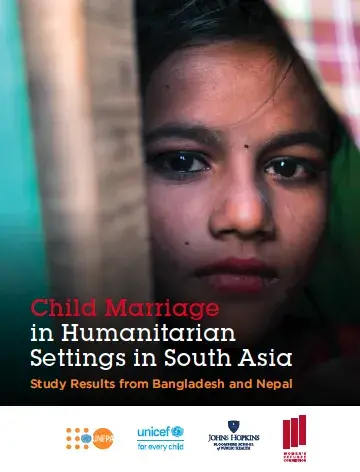Every child has a right to a childhood where they can play, where caregivers ensure their wellbeing, and where they are protected. Child marriage prevents this from happening and can result in serious human rights violations. In South Asia there are an estimated 285 million child brides. Fifty-nine per cent of women aged 20–24 in Bangladesh were married under the age of 18, 40 per cent in Nepal and 27 per cent in India. While the rates of child marriage are decreasing in the region, the vulnerability and insecurity that arises during humanitarian crises threatens to undermine this progress.
In South Asia, a region prone to natural disasters and one that has urgent and protracted conflicts, families may resort to child marriage during crises, as it is perceived to be the best means to provide economic and physical security. It can also be perceived as a way to preserve family honour and duty during crises and disasters that threaten the identity and security of those affected. While the drivers of child marriage may be similar, they are often heightened in emergency settings, and child marriage may be seen as a way to protect the family when the usual means of protection have disappeared. Humanitarian crises can also change prevailing social and gender norms in ways that reduce – or reinforce – the persistent gender inequalities that underpin and perpetuate child marriage.
This study challenges us to do better for children and young people in humanitarian situations – to urgently bolster economic and social security in those communities that practise child marriage so that this harmful practice does not increase as a result of the stressors families experience in crisis situations. Our programming must be more adaptive and responsive so that children and young people are empowered to shape their own futures and make their own choices, and parents and communities have the skills and empathy to support them. We also cannot forget the boys who are often excluded from programmes, and who also have the right to learn and grow up as responsible persons, able to make their own choices and empowered to have equal, respectful relationships.
The extent to which humanitarian settings impact child marriage practices and the processes through which they may modify its drivers are not fully understood. In an effort to establish an evidence base for child marriage in humanitarian settings, generally, and for South Asia, in particular, the United Nations Population Fund (UNFPA) Asia and the Pacific Regional Office (APRO) and the United Nations Children’s Fund (UNICEF) Regional Office for South Asia (ROSA) partnered with the Women's Refugee Commission and the Center for Humanitarian Health at the Johns Hopkins Bloomberg School of Public Health to conduct two country studies on child marriage in humanitarian settings in Bangladesh and Nepal.
This report combines the findings from research with conflict-affected Rohingya refugees from Myanmar residing in Bangladesh, and earthquake-affected communities in Nepal. The findings analyse similarities and differences across the contexts, in order to learn about these two settings and also to understand what might be generalized to child marriage in humanitarian settings more broadly.
The hope is that the findings from these studies will inform programme interventions in these settings and provide insight into child marriage in humanitarian contexts.


